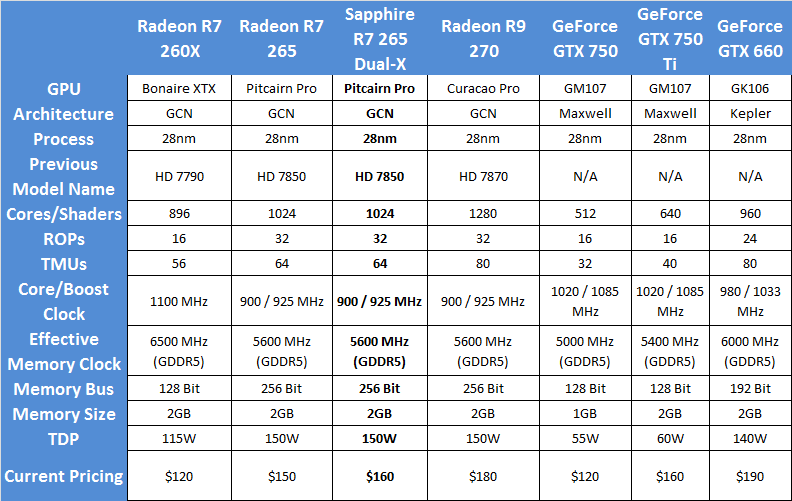Sapphire AMD Radeon R7 265 Dual-X 2GB Review
Introduction, Specifications and Packaging
 AMD’s R7 265 launch preceded that of the GTX 750 Ti by about 5 days. AMD’s R7 265 aimed to do what many of the current RX 200 series products already do – bring HD 7000 product rebrands into the latest generation at reduced prices with some minor software tweaks. The R7 265 is simply a rebranded HD 7850 but it does bring some new software features to the table like improved thermal/power management and easier Eyefinity that doesn’t require DisplayPort. At $150 the R7 265 aims to make up for what it lacks in power efficiency with all-out performance. Sapphire’s R7 265 Dual-X graphics card that we have here today typifies that value for money philosophy. With stock clocks and Sapphire’s renowned Dual-X cooler this graphics card is more or less sticking to reference pricing while still offering a significantly better cooler. While GTX 750 Ti graphics cards start at about $160-170 Sapphire’s Dual-X R7 265 can be easily found for $160 and $150 at some places if you hunt around.
AMD’s R7 265 launch preceded that of the GTX 750 Ti by about 5 days. AMD’s R7 265 aimed to do what many of the current RX 200 series products already do – bring HD 7000 product rebrands into the latest generation at reduced prices with some minor software tweaks. The R7 265 is simply a rebranded HD 7850 but it does bring some new software features to the table like improved thermal/power management and easier Eyefinity that doesn’t require DisplayPort. At $150 the R7 265 aims to make up for what it lacks in power efficiency with all-out performance. Sapphire’s R7 265 Dual-X graphics card that we have here today typifies that value for money philosophy. With stock clocks and Sapphire’s renowned Dual-X cooler this graphics card is more or less sticking to reference pricing while still offering a significantly better cooler. While GTX 750 Ti graphics cards start at about $160-170 Sapphire’s Dual-X R7 265 can be easily found for $160 and $150 at some places if you hunt around.
Specifications Analysis
As we mentioned Sapphire haven’t done much with the base R7 265 design except add their own custom Dual-X cooler. The clock speeds are all stock but we expect there will be plenty of overclocking headroom to access. At $160 street price this Sapphire card is on par with Nvidia’s GTX 750 Ti in terms of affordability but how does the performance and power consumption shape up? All will be revealed soon!

Packaging and Bundle
The product comes with Sapphire’s usual “Crysis-style” packaging.

The back details most of the usual AMD features but also Sapphire’s Dual-X cooler.

Included is a molex to 6 pin adapter, DVI to VGA adapters, driver CD and some documentation.










are these the card pull or the total system wattage?
card pull